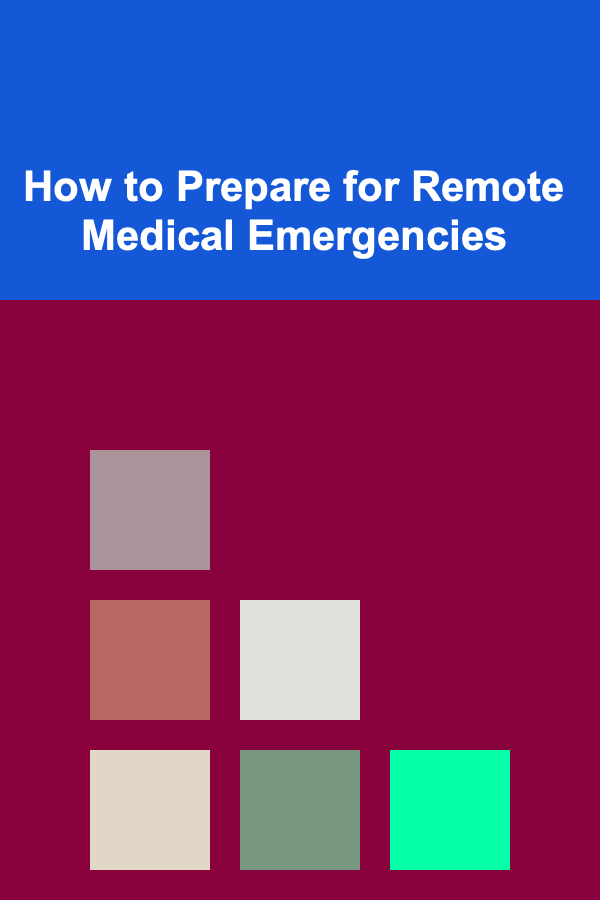
How to Prepare for Remote Medical Emergencies
ebook include PDF & Audio bundle (Micro Guide)
$12.99$5.99
Limited Time Offer! Order within the next:

When we think of medical emergencies, the image that often comes to mind is of a bustling hospital, an ambulance rushing through busy streets, and doctors and nurses tending to patients in a controlled environment. However, there are situations where medical emergencies can occur far away from the nearest medical facility, in remote or isolated locations. In these settings, whether you're hiking, camping, traveling, or even working in remote areas, being prepared for medical emergencies is crucial.
This article explores the importance of preparation for remote medical emergencies, provides strategies for handling emergencies, and outlines the essential equipment and knowledge that can help save lives when you're far from help.
Understanding Remote Medical Emergencies
A remote medical emergency can occur anywhere far from the reach of immediate professional medical assistance. These emergencies can arise in various scenarios such as:
- Outdoor adventures: Hiking, trekking, camping, or mountaineering in rural or isolated locations.
- Travel: Visiting remote regions in developing countries or working in isolated locations like research stations, offshore rigs, or remote villages.
- Work: Jobs in fields like forestry, agriculture, and construction, which may require individuals to work in remote settings where medical assistance is not readily available.
Some of the common medical emergencies that might arise in these situations include:
- Trauma injuries: Broken bones, cuts, and abrasions.
- Cardiac events: Heart attacks or strokes.
- Allergic reactions: Severe anaphylactic reactions.
- Infections: Infections that worsen due to inadequate medical treatment.
- Environmental emergencies: Heatstroke, hypothermia, altitude sickness, or dehydration.
Why Preparation is Key
Remote medical emergencies are especially dangerous because they combine the challenge of a health crisis with the difficulty of accessing medical help. In remote areas, it can take hours or even days for emergency services to reach you. Thus, having a solid understanding of how to handle medical emergencies, along with the right tools and preparation, can be a life-saving advantage.
1. The Element of Time
In remote settings, time is critical. The lack of immediate access to healthcare professionals means that individuals must act swiftly and efficiently to manage medical crises until help arrives. Even with timely communication to emergency services, reaching an emergency medical team could take a long time.
2. Limited Access to Resources
When far from the nearest clinic or hospital, you might not have access to even basic medical supplies. The facilities or medical staff might not be equipped to handle serious cases, so self-sufficiency and adaptability become paramount in such situations.
3. Increased Risk of Complications
Certain conditions, such as infections or heart issues, can worsen without prompt intervention. Environmental factors like extreme weather conditions, isolation, or limited resources further amplify the potential for complications.
Key Steps in Preparing for Remote Medical Emergencies
1. Build Your Medical Knowledge
Having basic medical knowledge is one of the most important tools when preparing for remote medical emergencies. Knowing how to recognize symptoms, provide first aid, and handle specific injuries or conditions will be crucial. It is not enough to simply rely on help that might arrive hours later; your ability to act quickly and effectively can determine the outcome of an emergency.
Here are some key areas to focus on:
- Basic First Aid: Learn how to perform CPR, bandage wounds, treat burns, and splint fractures. Many organizations, such as the Red Cross, offer first aid training that will equip you with the knowledge you need.
- CPR and Advanced Life Support: While basic CPR can save lives, gaining knowledge of advanced life support techniques will provide you with tools to manage more complex emergencies.
- Recognizing Symptoms: Learn the symptoms of common medical conditions, such as heart attacks, strokes, heat exhaustion, and hypothermia. The sooner you recognize these symptoms, the sooner you can take action.
- Handling Environmental Health Risks: Understand the dangers posed by the environment you're working or traveling in. Whether it's altitude sickness in the mountains, dehydration in the desert, or frostbite in the cold, knowing the risks and signs of these conditions will help you respond effectively.
2. Pack a Comprehensive First Aid Kit
A well-stocked first aid kit is essential for any remote journey. Your kit should be customized based on the type of activity you'll be engaged in and the potential medical emergencies that may arise. Consider the following items:
- Basic Supplies: Adhesive bandages, gauze pads, antiseptic wipes, medical tape, scissors, tweezers, and gloves.
- Medications: Painkillers (such as ibuprofen), antihistamines for allergic reactions, antibiotics (if prescribed), and any necessary prescriptions for pre-existing conditions.
- Tools for Trauma Care: A splint or foam padding for fractures, burn cream, and cold packs to treat injuries.
- Infection Prevention: Antiseptic solutions or ointments to prevent infection, sterile bandages, and hand sanitizers.
- Specialized Items: Items for specific needs such as an epinephrine injector for severe allergic reactions, anti-diarrhea medication, or a snake bite kit if you're venturing into an area where venomous snakes are common.
3. Consider Medical Communication Equipment
In some remote areas, having the means to communicate with medical professionals or emergency services can make all the difference. Depending on the location, various communication tools can be used:
- Satellite Phones: If you're traveling or working in a truly remote area without cell phone coverage, satellite phones provide a reliable means of communication. They allow you to call emergency services, family, or friends for help, even in the most isolated locations.
- Two-way Radios: For those working in teams, having two-way radios ensures that you can stay in constant communication, especially in environments where cellular service is not available.
- GPS Devices: In situations where you need to be located by rescuers, having a GPS device with accurate coordinates can help search and rescue teams find you quickly.
4. Understand Remote Medical Transport Options
In case of a medical emergency, understanding your options for evacuation is crucial. Consider the following:
- Helicopter Evacuation: In some remote locations, particularly in mountainous areas, helicopter evacuation may be the fastest method of transport. Check if the area you're going to has this option, and know the costs involved and the procedures for requesting such help.
- Land Evacuation: In areas with rugged terrain, an off-road vehicle may be necessary to transport a patient. Having trained personnel or knowledge of how to evacuate a victim in such conditions can be crucial.
- Emergency Medical Services (EMS): Depending on the location, there may be local EMS services that can provide transport. Ensure you know how to contact these services and whether they can reach you in time.
5. Learn Wilderness Medicine
Wilderness medicine involves the adaptation of medical principles to environments where traditional medical support is not available. Understanding wilderness medicine will significantly enhance your preparedness for remote emergencies. This includes:
- Managing Dehydration and Malnutrition: Learning how to safely purify water, avoid foodborne illnesses, and manage mild dehydration is crucial.
- Temperature Regulation: Understanding how to treat hypothermia, frostbite, and heat stroke is essential for outdoor activities in extreme climates.
- Handling Animal Bites or Stings: Knowing how to treat bites from wild animals, insects, or venomous creatures is an essential part of wilderness medicine.
6. Create a Safety Plan and Share It
Before heading into remote areas, it's important to create a safety plan. This should include details about your location, expected timeline, emergency contacts, and medical conditions. Share this plan with someone who will not be traveling with you, so they can act as a backup contact if something goes wrong.
Make sure your plan includes:
- Emergency Contacts: Have a list of medical professionals or services that can provide advice in emergencies.
- Location Details: Provide specific details about your route, destinations, and check-in points. GPS coordinates can be especially helpful in remote areas.
- Evacuation Routes: Ensure you have a clear understanding of how to get out of the area if necessary and the logistics of evacuation.
7. Stay Informed and Flexible
When traveling or working in remote areas, conditions can change rapidly. Stay informed about the weather, natural hazards, and any potential outbreaks of diseases in the area. Having access to real-time updates and maintaining flexibility in your plans is important for minimizing risks.
- Monitor Weather Conditions: Extreme weather can drastically change the landscape and make remote areas more dangerous. Be prepared to change your plans if necessary.
- Local Health Advisories: In some remote regions, diseases such as malaria, dengue, or other infectious diseases may be common. Being aware of potential health threats and taking necessary precautions (such as vaccinations or medications) is critical.
Conclusion
Preparing for remote medical emergencies is not just about having the right equipment; it's about having the right mindset and knowledge to respond effectively when the unexpected happens. While no amount of preparation can guarantee that you will avoid medical emergencies, it can significantly increase your chances of managing a crisis successfully.
By gaining the right medical knowledge, packing the necessary supplies, ensuring you have reliable communication tools, and understanding how to evacuate in the event of an emergency, you can increase your safety and reduce the risk of complications. Preparation is not only about surviving; it's about thriving, even in the most challenging and remote environments.

Artistic Influence: Crafting Visual Narratives as an Art Director
Read More
How to Make a Checklist for Building a Marketing Plan for Product Launch
Read More
How to Tackle Student Loan Debt While Maintaining a Balanced Life
Read More
The Environmental Consultant's Guide: Strategies for Sustainable Solutions
Read More
How to Start Via Ferrata: Climbing Iron Paths
Read More
How to Turn User Research Insights into Actionable Design Recommendations
Read MoreOther Products

Artistic Influence: Crafting Visual Narratives as an Art Director
Read More
How to Make a Checklist for Building a Marketing Plan for Product Launch
Read More
How to Tackle Student Loan Debt While Maintaining a Balanced Life
Read More
The Environmental Consultant's Guide: Strategies for Sustainable Solutions
Read More
How to Start Via Ferrata: Climbing Iron Paths
Read More